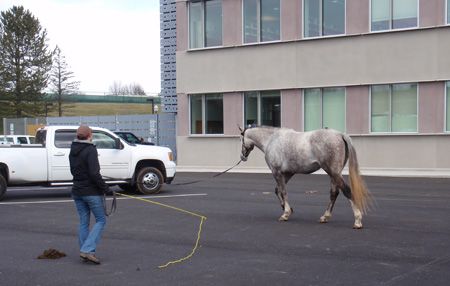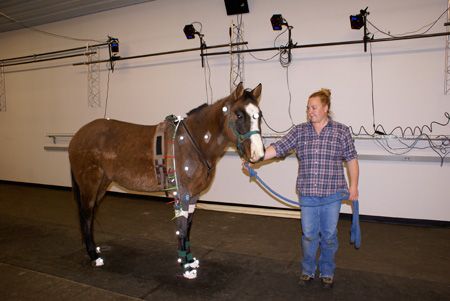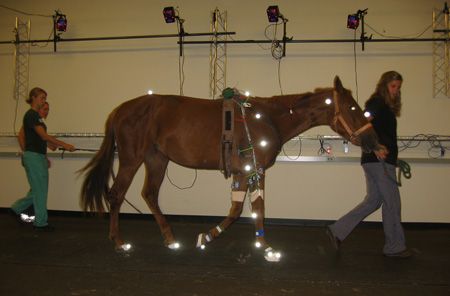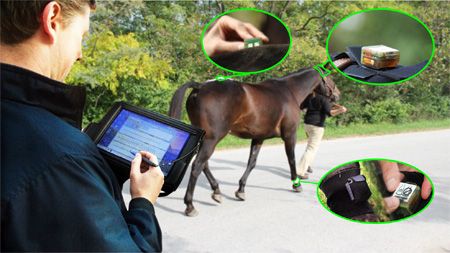Equine lameness: Subjective versus objective assessment
Veterinary researchers are weighing in on this question critical to optimal horse health and owners' pocketbooks.
Lameness is a common reason horses present to equine practitioners. Federal researchers note that lameness has the highest annual incident density of all medical problems in horses-half of all horse operations with five or more horses experience one or more cases of lameness annually.1 Another report estimates lameness incidence at 7.5% to 13.7% annually.2
Assuming there are 9.2 million horses in the United States, at $432 spent on veterinary services per lameness incident, more than $500 million is being spent on lameness diagnosis and treatment per year. Horse owners' annual total financial loss attributable to lameness-that is, the loss of use cost as well as veterinary spending-is estimated to exceed $1 billion.1
Fortunately, about 70% of all lameness incidents result in recovery. Successfully treating the 30% that won't recover without proper diagnosis and treatment is the predicament. Aids in detecting and measuring lameness are most helpful in these cases.
Subjective classification and assessment
The American Association of Equine Practitioners' lameness guidelines judge lameness according to a five-point scale, with zero noted as normal or sound and five representing maximum lameness.
> Grades 1 and 2, which are more difficult to observe or discern, are assessed while the horse is walking or trotting in a straight line with some difficulty.
> Grade 3 is further lameness, determined while the horse is trotting.
> Grade 4 lameness is detectable at the walk.
> Grade 5 is lameness so severe it causes the horse to bear minimal or no weight in motion or at rest, or to be unable to move.
Compensatory lameness involves asymmetric movement when the horse shifts weight from a painful to a normal limb. Over time this can lead to pain in an otherwise normal limb from overloading, a condition known as secondary lameness.

A horse being evaluated for lameness by subjective observation. Photo courtesy of Dr. Kevin Keegan, University of Missouri College of Veterinary Medicine.
Subjective lameness evaluation, in which a clinician visualizes local, regional and whole-body movements, is the accepted standard for clinical lameness detection, says Josh Donnell, DVM, of Colorado State University and his colleagues.3 Unfortunately, there can be poor agreement among veterinary evaluators even about the same animal's lameness. Therefore, more objective assessment measures have been sought.
Two objective assessment methods
Soundness and lameness in horses can be objectively quantified through biomechanics, using mechanical principles to observe the horse in motion. Video capture and other line-of-sight techniques are the most straightforward to understand, but for practical reasons they are difficult to implement routinely in over-ground situations. The other two objective potentially useful methods are the force plate or platform (FP) and the body-mounted inertial sensor system (ISS).

A horse standing with its forelimbs positioned on a force plate to assess compensatory forelimb weight bearing changes in response to the chronic left hind fetlock injury. Photo courtesy of Dr. Kevin Haussler, Colorado State University Equine Orthopedic Research Center.
With a force plate, the horse strikes a flat piece of metal that measures force of weight-bearing. The FP can measure ground reaction forces in the three axes-X, Y and Z (three-dimensional space)-giving a reading of each. “It also tells you how much impulse the horse is going through, as well as how long the horse is putting weight on [an affected limb], or its stance duration,” says David Frisbie, DVM, PhD, DACVS, DACVSMR, professor in the Department of Clinical Sciences at Colorado State University College of Veterinary Medicine.


Horses standing and trotting on two force plates with reflective markers attached to measure forelimb joint movements with kinematics and electromyography to measure forelimb muscle activation. Photos courtesy of Dr. Kevin Haussler, Colorado State University Equine Orthopedic Research Center.
A close look at the difference
FP is a direct measure of force, or weight-bearing, while ISS measures symmetry. With FP, the lesser the force, the greater the limb lameness. “The detriment is that FP is a little more finicky piece of machinery,” says Frisbie. “The unit is mounted flush with the ground the horses trot on, and the horses can see it as they strike it.” ISS measures head and pelvic movement with a greater number of strides, Frisbie says, and the horse can simply “wear” it in a more natural way, allowing examination of the horse in motion in its natural environment.
One such ISS includes two sensors-one that attaches to the head and one to the pelvis. ISS senses lameness as asymmetric acceleration of the head or pelvis during weight-bearing of one side of the body to the other. A third sensor on a limb (the right front limb in the system used by Frisbie and Donnell), a gyroscope, is necessary only to determine when the right foot is on the ground and when it's not and signals where the analysis should start.

FIGURE: ISS: An inertial sensor system (ISS; Lameness Locator-Equinosis) captures live motion data through wireless sensors for analysis. Photo courtesy of Equinosis.
“By knowing that, and knowing what gait a horse is at, you can then tell what leg should be on the ground, and therefore determine its movement, right front to left hind, letting you know how the horse is acting in its gait as it walks or trots,” Frisbie explains. “The ISS produces an output based on that acceleration, which limb it thinks the lameness is coming from and where the asymmetry is greatest.
“Basically, it determines a baseline degree of asymmetry,” Frisbie continues. “And once that baseline has been exceeded, the horse is considered lame. ISS gives the practitioner an indication of the soreness severity and where the soreness is coming from. It also tells you whether the lameness occurs when the horse is attempting to push off or when it's landing.”
Lessons for all equine practitioners
“One thing the user has to accept in order to understand the utility of this type of equipment is that vertical motion of the torso is more critical to assessing lameness than observing motion of the legs,” says Kevin Keegan, DVM, MS, DACVS, professor of equine surgery at the University of Missouri College of Veterinary Medicine and director of the E. Paige Laurie Endowed Program in Equine Lameness.
Because the head is a massive object connected to the center of body mass on a long lever arm, its vertical movement is a highly efficient method of unloading a painful forelimb-so much so that it trumps all other movement adjustments available to a horse that's trying to minimize limb pain, Keegan says. He teaches his students to stop looking at the legs, at least in the initial lameness evaluation. Limb-movement parameters such as decreased stride length can confirm but not negate vertical head-movement parameters.
“The same can be said, but to a lesser extent, for vertical movement of the pelvis in hind-limb lameness,” Keegan continues. “Limb movement and pelvis rotation, because they're affected by other causes besides lameness, can confirm but not negate vertical movement of the entire pelvis.”
The other concept for practitioners to understand? Lameness is a clinical sign, not a disease. “The sensors are stupid,” Keegan says. “They detect only the lameness. But they never lie, as long as they're put on properly. They can detect but not evaluate lameness. The veterinarian still has to do the heavy work.”
The results of an ISS evaluation correlate with limb pain, because it's a simple physical relationship, but pain in the leg is not the only cause of lameness, Keegan says. “I've always stressed that the better one is, and the more experience one has, at evaluating lameness in horses [subjectively], the more benefit one will realize measuring it objectively,” he says.
Comparative studies to more accurately determine lameness
In cases of lameness, “horses don't tell us what's painful and how painful it is,” Frisbie says. “It's difficult to determine, and that's the problem. We're searching for a gold standard where, unfortunately, there's clearly none obtainable at this time.”
Frisbie's goal in a recent study was to compare the relationships between FP, ISS and a subjective exam.3 In the study, researchers looked at each diagnostic tool in a group of 16 horses with a consistent mild lameness.
“That's about as good as we can get right now in comparatively assessing mild lameness in horses as it relates to joint problems and trying to approach a gold standard,” says Frisbie. “Horses are somewhat like us: One day they get up and their neck hurts, on another day their hip or lower limb hurts. The horses in this study are subject to those same issues-more than just the carpus may be a source of everyday pain.”
In the horses studied, once researchers looked at the correlation of their accepted method-a subjective lameness exam compared with objective measurements-the relationship was stronger with the ISS than with the FP. “There could be some bias, because the ISS was built around trying to emulate what we saw subjectively,” Frisbie notes. “The FP is not. It's objective; you can't sway its results in any way-a matter of measuring the force as the foot strikes the FP. Lack of force or lesser force equates to lameness to a specific degree as measured.”
A role for both objective methods
Asymmetry is something the ISS does very well. And determining the amount of force in raw numbers-how much force is put on a limb in multiple axes-is what the FP does better, the researchers note. “Each is going to work better than the other in different situations,” states Frisbie. “Because in this study the ISS was better in most outcomes, we don't want to insinuate that the FP is not a useful tool.”
In their study, though, based on evaluating what would be expected, the ISS did better than the FP.3 Forelimb lameness was assessed in the 16 horses at four time points using subjective assessment, FP and ISS. Independent of time, blinded subjective evaluation (54%) and ISS (60%) identified a higher percentage of horses as lame in the appropriate limb compared with FP (40%). Blinded subjective evaluation and the ISS agreed which forelimb was lame more often (50%), compared with blinded subjective evaluation and the FP (38%). The percentage of horses identified as lame in the appropriate limb, independent of time, was highest with the ISS (60%), followed by subjective evaluation (51%) and FP (42%).3
“With the FP, they have only five strikes, but that's what's accepted, versus 20 strikes with the ISS, and the horse has to hit it just right,” says Frisbie. “There are several parameters you have to work with when you use it. With the ISS, you're collecting more data; it's going to be a little tighter. Some of those things are going to help the assessor make a better determination.”
Keegan agrees that precise lameness detection, regardless of method, requires collection of multiple contiguous strides. “You cannot do it precisely looking at a few single stride samples,” he says.
But Frisbie also notes that some horses have pain in both front limbs, which makes ISS less useful. “If pain is identical on the left and the right, we would not be able to see that with the ISS, but we would be able to detect that change with the FP,” he says. “There has to be significantly more pain on one side versus the other for the ISS to detect it.”
Frisbie continues that some studies show FP working better than the ISS. “It depends on the nature of [the horse's] pain, whether it's bilateral or ipsilateral,” he says. “But this study concluded that subjective lameness assessment plus ISS produced better agreement of lameness-superior to the FP and subjective assessment.”
References
1. USDA. Lameness and laminitis in U.S. horses. USDA:APHIS:VS, National Animal Health Monitoring System. Information Sheet. Fort Collins, Colorado: October, 2000. #N318.0400
2. USDA. National economic cost of equine lameness, colic, and equine protozoal myeloencephalitis in the United States. USDA:APHIS:VS, National Health Monitoring System. Information Sheet. Fort Collins, Colorado: October, 2001. #N348.1001.
3. Donnell JR, Frisbie DD, King MR, et al. Comparison of subjective lameness evaluation, force platforms and an inertial-sensor system to identify mild lameness in an equine osteoarthritis model. Vet J 2015;206:136-142.
Suggested reading
• Keegan KG. Evidence-based lameness detection and quantification. Vet Clin North Am Equine Pract 2007;23:403-423.
• Keegan KG, Kramer J, Yonezawa Y, et al. Assessment of repeatability of a wireless inertial sensor-based lameness evaluation system for horses. Am J Vet Res 2011;72(9):1156-1163.
• Keegan KG, Yonezawa Y, Pai PF, et al. Evaluation of a sensor-based system for analysis for detection and quantification of forelimb and hind limb lameness in horses. Am J Vet Res 2004;65(5):665-670.
• Keegan KG, Dent EV, Wilson DA, et al. Repeatability of subjective evaluation of lameness in horses. Equine Vet J 2010;42(2):92-97.
• Donnell JR, Frisbie DD. Correlation between an inertial-sensor system and clinical evaluation for estimating degree of improvement post-diagnostic analgesia, in Proceedings. Am Assoc Equine Pract 2015;61:455.
Ed Kane, PhD, is a researcher and consultant in animal nutrition. He is an author and editor on nutrition, physiology and veterinary medicine with a background in horses, pets and livestock. Kane is based in Seattle.
Newsletter
From exam room tips to practice management insights, get trusted veterinary news delivered straight to your inbox—subscribe to dvm360.